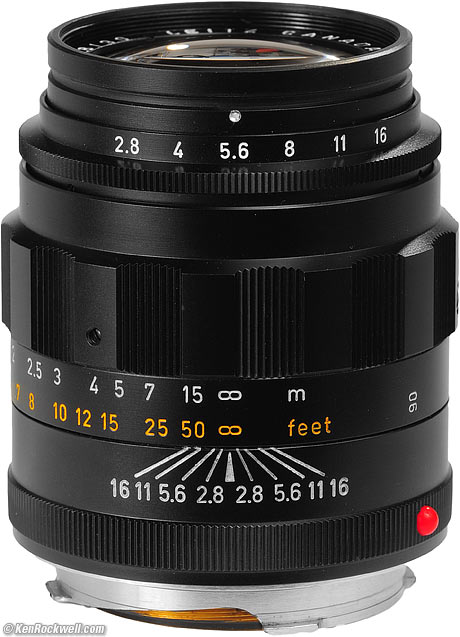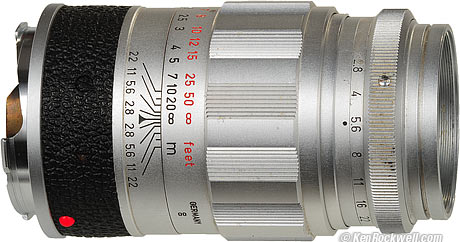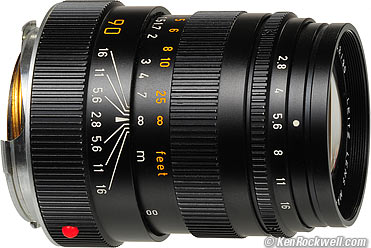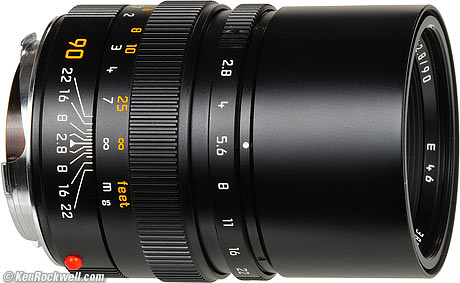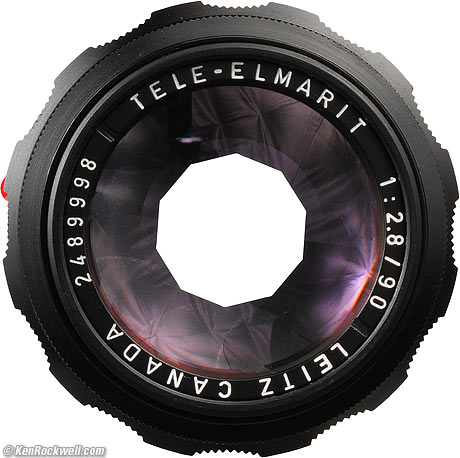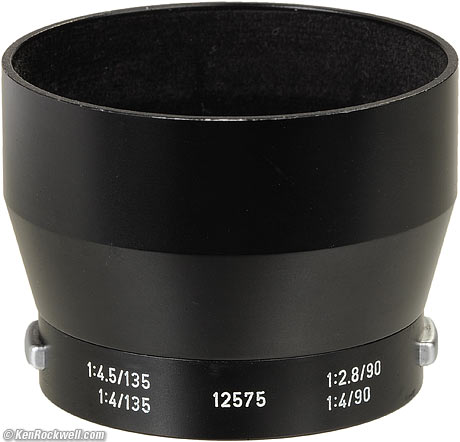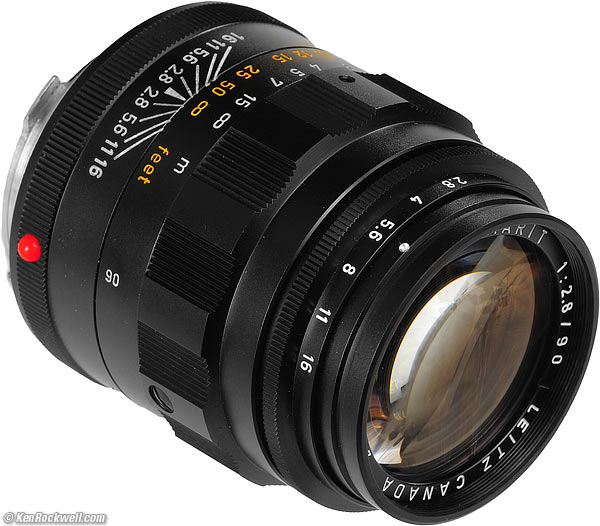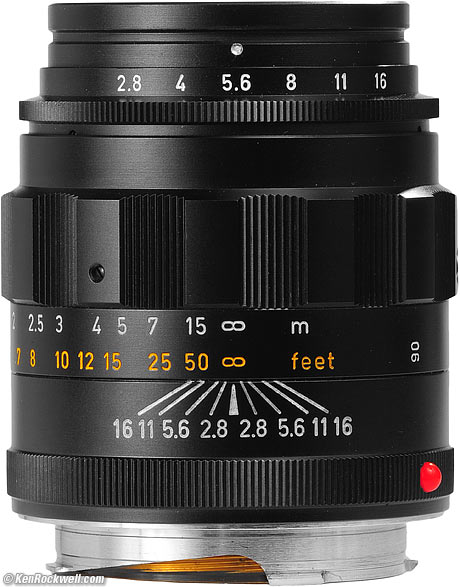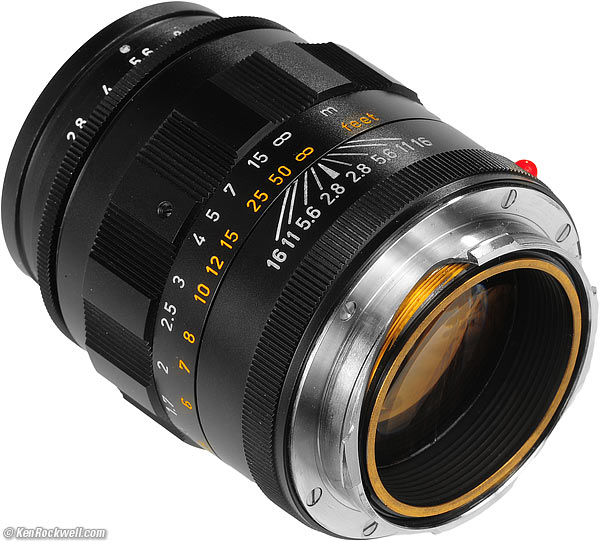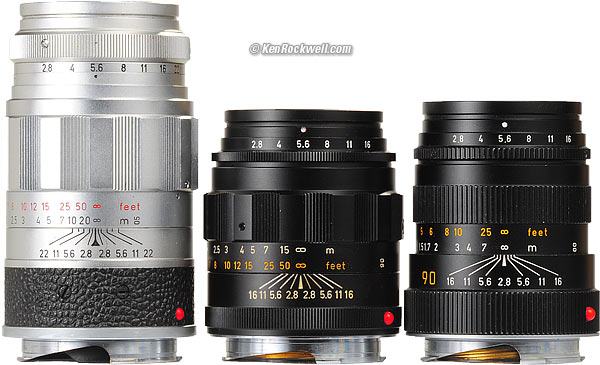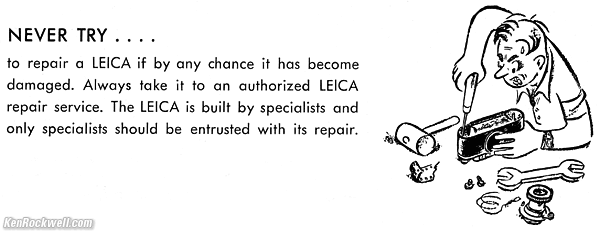Home Donate New Search Gallery How-To Books Links Workshops About Contact
LEICA 90mm f/2.8
LEITZ TELE-ELMARIT
(1964-1974)
© 2010 KenRockwell.com. All rights reserved.
Intro Specs Performance Compared Recommendations
LEICA TELE-ELMARIT 90mm f/2.8 "fat" (39mm filters, 11.977 oz./339.55g, about $650 used). Vergrößern. You can get them at this link to them at eBay; you also can get them from Adorama and OC Camera. It helps me keep reviewing these oldies when you get yours through these, links, thanks! Ken.
February 2010 LEICA Camera Reviews LEICA Lens Reviews
LEICA 90mm f/2.8 Lenses Compared
LEICA 90mm f/2 Lenses Compared
Introduction top
Intro Specs Performance Compared Recommendations
|
I personally buy from Adorama, Amazon, Ritz, B&H, Calumet and J&R. I can't vouch for ads below.
|
This LEICA TELE-ELMARIT 90mm f/2.8 was the compact alternative to LEICA's popular LEICA ELMARIT 90mm f/2.8 (1958-1974).
Originally pitched by Leica as the "long-focus dwarf" (no kidding), it was sold to allow the 90mm lens to fit on your camera inside an ordinary never-ready case.
It sold for the same price as the full-size ELMARIT. LEICA cautioned that performance was intended more for casual shooting. however my comparisons on the LEICA M9 show surprisingly that this tele clearly outperforms the larger ELMARIT.
The "TELE" refers to the formal definition of a true telephoto design, where the lens is shorter than the actual focal length. The 90mm ELMARIT is as long as its focal length, while this TELE-ELMARIT is shorter.
Compatibility top
The LEICA 90mm f/2.8 TELE-ELMARIT works perfectly on every LEICA M camera, from the LEICA M3 of 1954, Minolta's CLE, and of course today's LEICA M7, LEICA MP and LEICA M9.
Unlike the ELMARIT, the lens head of this TELE-ELMARIT does not remove for use on the VISOFLEX.
History of the 90mm f/2.8 top
For details, see LEICA 90mm f/2.8 Lenses Compared.
1959-1974: ELMARIT
LEITZ ELMARIT 90mm f/2.8.
First came the ELMARIT.
All were made in Germany.
1964-1974: TELE-ELMARIT
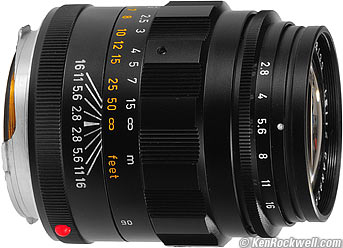
LEITZ TELE-ELMARIT 90mm f/2.8.
This TELE-ELMARIT came out five years later, and was sold alongside the longer ELMARIT.
They sold for the same price.
The ELMARIT was supposed to have offered better optics, while this smaller TELE-ELMARIT was smaller to fit in a camera case, however, I discovered that this TELE-ELMARIT is better than the ELMARIT.
These were all made in Canada.
1974-1990: TELE-ELMARIT-M
LEITZ TELE-ELMARIT-M 90mm f/2.8.
The newer 90mm f/2.8 TELE-ELMARIT-M replaced both of the previous lenses.
Its performance is about the same as the previous TELE-ELMARIT.
It was mostly made in Canada, with the last few years of production made in Germany.
1990-2008: ELMARIT-M
LEICA ELMARIT-M 90mm f/2.8.
The ELMARIT-M replaced the TELE-ELMARIT-M, with performance far beyond any previous 90mm lens. It was also bigger and heavier than any previous f/2.8 90mm LEICA lens.
All were made in Germany.
Specifications top
Intro Specs Performance Compared Recommendations
Name
Leica calls this the LEICA TELE-ELMARIT 90mm f/2.8.
The newer version is called distinctly the TELE-ELMARIT-M; laymen sometimes slur this fine TELE-ELMARIT with the pejorative "Fat."
Optics top
Cross-section. Vergrößern.
5 elements in 5 groups.
Single-coated mostly in magenta.
Diaphragm
LEICA TELE-ELMARIT 90mm f/2.8 at f/5.6. Vergrößern.
10 blades.
Stops down to f/16.
Half-stop clicks.
The diaphragm has straight edges from f/3.4 through f/5.6.
It has inwardly-curved edges from f/6.7 through f/13.
It is perfectly round at f/16.
Close Focus
1 meter (3' 4" or 40").
Size top
52.97mm diameter, maximum (focus ring).
59.43mm (2.340") extension from flange, 66.2mm (2.61") overall.
Filters
39 x 0.5mm screw-in filters (E39).
Attachments
A42 (42mm outside diameter).
Weight top
11.977 oz. (339.55g), measured.
12.5 oz. (355g), rated.
Hood top
LEICA 12 575 hood. Vergrößern.
The hood snaps on. This is the newer version; the older version was marked for 9 cm and 13.5 cm lenses and has a chrome ring. They do the same thing.
Caps top
Front cap
For front of lens: 14 122 (A42). Today's replacement is the snap-on plastic 14 038.
To fit over reversed 12 575 hood: 14 033.
Rear cap
14 051.
Today's standard 14 269 cap works great.
Part Numbers top
Lens: 11 800.
Cap for front of lens (no hood): 14 122.
Hood: 12 575.
Cap to fit over reversed 12 575 hood: 14 033.
Rear Cap: 14 051. (Today's standard 14 269 cap works great.)
Quality top
Made in Canada.
LEICA LEITZ TELE-ELMARIT 90mm f/2.8. Vergrößern.
Performance top
Intro Specs Performance Compared Recommendations
Bokeh top
Bokeh, the quality of out-of-focus areas as opposed to the degree of defocus, is wonderful. Backgrounds never distract.
f/2.8: Neutral to somewhat mediocre. Blur circle edges are very slightly enhanced.
f/4 - f/8: Perfect. Blur circles have soft edges and are perfectly round.
Here are crops from extremely enlarged prints of about 36 x 48" (100 x 150cm), or the equivalent of looking at LEICA M9 images at 100% on-screen.
In these examples, a vertically polarized phase lattice was set up at 3 meters (10 feet) on which the TELE-ELMARIT was focused, and the synthetic reference vegetation seen out of focus in the background was at 15 meters (50 feet).
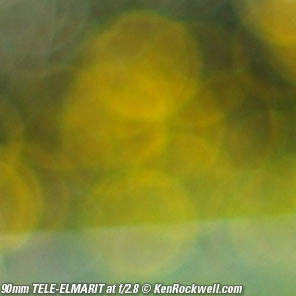 |
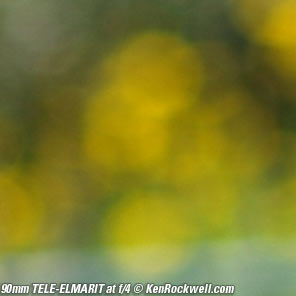 |
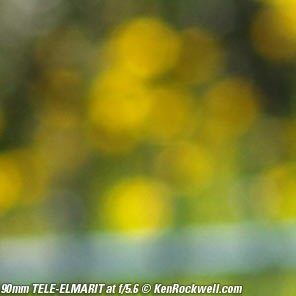 |
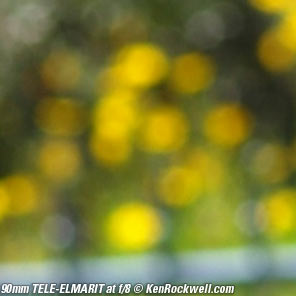 |
Diaphragm Calibration top
The calibration is perfect.
The meter in my M9 tracks each full-stop click perfectly, except of course full aperture.
Distortion top
The LEICA TELE-ELMARIT 90mm f/2.8 has no visible distortion.
For very critical photogrammetric use, use a value of +0.2 in Photoshop's lens distortion filter at 3 meters (10 feet).
This is better than the newer LEICA 90mm f/2.8 TELE-ELMARIT-M (1974-1990), which has some slight pincushion distortion. The newest LEICA 90mm f/2.8 TELE-ELMARIT-M (1990-2008) has no visible distortion.
Ergonomics top
LEICA TELE-ELMARIT 90mm f/2.8. Vergrößern.
The LEICA TELE-ELMARIT 90mm f/2.8 handles great.
It's easy to focus and to adjust the aperture, with or without the hood attached.
Focus is geared just right: it turns from infinity to 1 meter in 180º.
Finder Blockage top
There is no blockage without the hood.
With the 12 575 hood, there is negligible blockage at infinity, increasing to moderate blockage at 1 meter.
Focus top
Focus accuracy is a personal issue between your sample of body and your sample of lens.
This said, this particular sample was perfect on my M9, much better actually than the 90mm f/2 APO ASPH I've used, meaning that for practical purposes, this old TELE gives much sharper results on my M9 because it's in better focus!
Falloff (darker corners) top
The LEICA 90mm f/2.8 TELE-ELMARIT has no visible falloff. This is much better than the 90mm f/4 ELMAR-C, for example.
I've greatly emphasized it below by shooting a gray field and presenting it against another gray field
LEICA TELE-ELMARIT 90mm f/2.8 falloff on full-frame M9 at infinity,
© 2010 KenRockwell.com. All rights reserved.
|
Lateral Color Fringes top
There no color fringes anywhere, either on film or on a LEICA M9.
Materials and Construction top
This TELE-ELMARIT is made of solid metal. The only plastic is the red mounting index ball.
To save weight, much of the outer barrel and control rings are made of anodized aluminum, with brass for the helicoids and most of the internals.All the marking are engraved and filled with paint.
Sharpness top
The more you know about photography, the more you know that lens sharpness doesn't matter.
If you're silly enough to think that lens sharpness affects picture sharpness, use the newest LEICA ELMARIT-M 90mm f/2.8 or the LEICA APO-SUMMICRON 90mm f/2 ASPH instead. This classic lens isn't as sharp.
If you worry about it, stop down.
As shot on the LEICA M9
f/2.8
Softer all over.
The center is slightly lower contrast, while the sides and corners are much softer.
f/4
Everything is much sharper and contrastier at f/4 than at f/2.8.
The center is already optimum at f/4.
The the far sides and corners are still a bit blurry.
f/5.6
The sides and corners are better, but still a bit blurry.
f/8
The center is slightly softer at f/8.
The sides are still a bit blurry.
Rear, LEICA TELE-ELMARIT 90mm f/2.8. Vergrößern.
Compared top
Intro Specs Performance Compared Recommendations
ELMARIT, this TELE-ELMARIT, and TELE-ELMARIT-M. Vergrößern.
This 90mm f/2.8 TELE-ELMARIT is much better than its contemporary ELMARIT (1959-1974).
This 90mm f/2.8 TELE-ELMARIT is about the same as the newer 90mm f/2.8 TELE-ELMARIT-M (1974-1990). When I compared them at the test range, they would vary by aperture and location in the image field, so there is no clear winner between them.
On film, any of these is wonderful.
The newest ELMARIT-M (1990-2008) is far superior optically, but almost twice the weight of the others.
If you're counting every pixel on the M9, you'll want the newest ELMARIT-M (1990-2008) or APO-SUMMICRON-M 90mm f/2 ASPH (1998-).
Specification Tables
LEICA 90mm f/2.8 Lenses Compared
LEICA 90mm f/2 Lenses Compared
TELE-ELMARIT |
||||
| Anni | 1959-1974 |
1964-1974 |
1974-1990 |
1990-2008 |
| Filter | 39mm |
39mm |
39mm |
46mm |
| Hood | built-in |
|||
| Front attachments | A42 |
A42 |
A42 |
none |
| Focus | Normal |
Normal |
Fast |
Normal |
| Weight | 333g |
340g |
226g |
395g |
| Weight | 11.7 oz. |
12.0 oz. |
7.95 oz. |
13.9 oz. |
| Distortion | none |
+0.2 |
-1.2 |
-0.5 |
| Sharpness | Good |
Very good |
Very good |
Excellent |
| Price, used, 3/2010 |
Recommendations top
Intro Specs Performance Compared Recommendations
I love the newer and even lighter-weight TELE-ELMARIT-M (1974-1990).
This older TELE-ELMARIT (1964-1974) has equivalent optics, with more weight, in the same-sized package. Focus accuracy is excellent.
If you can find one of these TELE-ELMARIT at a good price, get it. It could easily be the only LEICA 90mm lens you ever need.
Otherwise, I think the more common, newer TELE-ELMARIT-M sells for a little less money and I prefer the lighter weight.
If you prefer a more solid-feeling small lens, get this TELE-ELMARIT.
If you count every pixel on an M9, get the newer ELMARIT-M (1990-2008) is far superior optically, but almost twice the weight of the others.
Deployment top
For use with color transparency film outdoors, I prefer a 39mm B+W 81A filter.
For B&W outdoors, you want a yellow filter standard, like the B+W 39mm #022, or a B+W 39mm orange filter for more contrast, especially in the skies.
For color print film or digital, you want a LEICA 39mm silver-ring UV filter for protection, or go commando.
(the old, forgotten LEICA M8 (2006-2009) needed a LEICA 39mm silver-ring IR filter.)
These TELE-ELMARITs are 40 years old. If I need service, I use LEICA specialist Gus Lazzari, who can do amazing things and not leave any marks on our classic equipment.
Acknowledgements
Many thanks to OC Camera who loaned me this lens to review.
Help me help you top
I support my growing family through this website, as crazy as it might seem.
If you find this as helpful as a book you might have had to buy or a workshop you may have had to take, feel free to help me continue helping everyone.
If you've gotten your gear through one of my links or helped otherwise, you're family. It's great people like you who allow me to keep adding to this site full-time. Thanks!
If you haven't helped yet, please do, and consider helping me with a gift of $5.00.
The biggest help is when you use any of these links when you get anything. It costs you nothing, and is this site's, and thus my family's, biggest source of support. These places always have the best prices and service, which is why I've used them since before this website existed. I recommend them all personally.
Thanks for reading!
Ken
Home Donate New Search Gallery How-To Books Links Workshops About Contact

